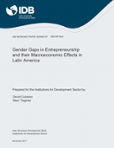Gender Gaps in Entrepreneurship and their Macroeconomic Effects in Latin America
Date
Nov 2017
This paper studies the aggregate effects of the existing differences between male and female-run firms in Latin America and the Caribbean (LAC). Using data from the World Bank Enterprise Survey and the International Labor Organization (ILO), we show that only about one-fourth of the total firms are run by women and that female-run firms are about three times smaller than male-run firms in LAC. We then extend the theoretical framework in Cuberes and Teignier (2016) to account for these facts and quantify their aggregate effects on productivity and income per capita. In our model, men and women are identical in all aspects except for the fact that some women face barriers to becoming entrepreneurs, which may be a function of their talent. The calibration of our model implies that the barriers that some women face to becoming firm managers depend positively on their managerial talent, which results in female-run firms being smaller than those managed by men in equilibrium. In our baseline simulation, we obtain an output per capita loss due to these gender gaps of 9.4 percent, all of which is due to misallocation of resources and the resulting fall in aggregate productivity. This loss is 1.3 times larger than the one obtained in a framework where barriers to entrepreneurship were assumed to be independent of talent.




